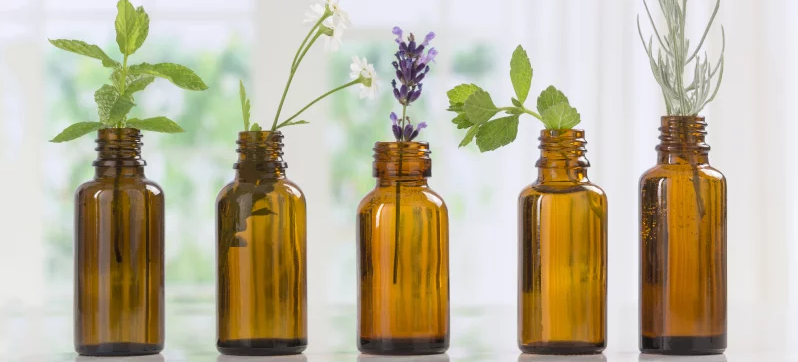Essential oils are most often used in aromatherapy, a form of alternative medicine. The oil consists of the corresponding plant’s scent or essence and each oil has its own unique characteristics or health benefits.
How Do Essential Oils Work?
Essential oils are most often inhaled or used topically on the skin. When this is done, the oils interact with your body in a number of different ways.
Topical Applications
For example, when used topically, the skin easily absorbs the activeorganic chemicals in the oils.
To increase skin absorption, you can massage the area first to help increase the circulation. This will cause the essential oils to absorb into the skin at a faster rate.
Inhalation of Essential Oils
When inhaled, you are breathing in through your nose and the essential oils then interact with your olfactory system. Inhalation can also allow the molecules to affect your brain while interacting with your limbic system. Your limbic system is more commonly known as the emotional brain and it is responsible for controlling several primary functions of the body. This includes our heart rate, blood pressure, breathing, and hormone balance.
The Many Uses of Essential Oils
Essential oils are used for a many different physical or mental conditions including depression, anxiety, sleeping problems, pain, stress, hormonal imbalance, and so much more. If you are feeling anxious, then simple smells like lavender and rosewater may be all you need to calm you down.
When using essential oils, you need to make sure that they are properly diluted so they are safe to apply topically to your skin. Coconut oil and jojoba oil are two of the more common carrier oils you can use to mix with your essential oils.
The following is a list of some of the most common essential oils and their uses:
Bergamot: This is used for skin healing and to help reduce anxiety.
Eucalyptus: this can be used as a topical pain reliever and can also help with respiratory infections.
Frankincense: this can help lower stress levels while also enhancing your mood.
Lavender: this essential oil is very calming and can help promote better sleep.
Lemon: this is often used as a natural household cleaner as well as disinfectant.
Rosemary: this can help improve your skin, hair health, and can also help with joint pain.
Other Uses of Essential Oils
Essential oils can also be used for a variety of other things. Tea Tree oil, for example, is an antiviral and anti-inflammatory oil that has been shown to kill bacteria, treat gingivitis, help with moderate dandruff, kill the influenza virus, and treat acne.
When treating acne, it is just as effective as benzoyl peroxide but does not dry out the skin. It can also help with rosacea and other skin problems you may be experiencing.
Cinnamon essential oil is good for therapeutic use and is often used to help clear up chest colds. It can also be applied topically to help with pain or muscle aches because of its many antispasmodic and analgesic properties.
Benefits of Essential Oils
When determining the effectiveness of essential oils, however, there are several factors to take into consideration.
Accessibility, affordability, efficacy, potency, and the available applications are all what need to be considered when purchasing essential oils for aromatherapy or topical use. With essential oils, you can boost your energy levels, relieve headaches or migraines, calm nerves while retaining your focus, treat a variety of different skin conditions, find pain relief for sore muscles or joints, reduce stress, and improve the look/feel of your hair and skin.
Essential Oils and Aromatherapy
When using essential oils in aromatherapy, the best method of doing so is by using a nebulizing diffuser.
When diffusing, you are simply spreading out the essential oils through the air. Nebulizing diffusers do not require water or heat to work. Instead, they use pressurized air that streams from the specially designed jet nozzles.
Not introducing the essential oils to heat or water allows them to maintain their integrity and does not change the chemical compounds when they are diffused. Therefore, you are breathing in the oil in its purest form which will prove to be far more effective than if destroyed by heat or diluted in water.
The nebulizing diffuser breaks the essential oils down into tiny particles then evenly disperses them in the air. They work fast so you can quickly take advantage of the essential oil benefits.
When starting your nebulizing diffuser journey, you should consider purchasing a starter set because it comes with a variety of essential oils you could try out at home. Simply assemble the diffuser, add approximately 20-25 drops of your favorite essential oil to the reservoir, add the glass spout top and turn it on.
It is recommended to use the diffuser for 15 minutes at a time, so your olfactory system has time to process the essential oils.
Final Thoughts
When you choose to use essential oils as an alternative and safer form of treatment for certain conditions or ailments, you are exposing yourself to a plethora of health benefits. You can improve your overall quality of life while taking full advantage of the therapeutic use of essential oils extracted from plants. It is a more natural, effective, and safe form of treatment to consider for a number of ailments including chronic health conditions.


